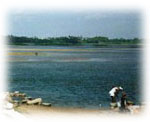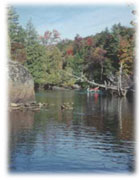 CAUVERY
:
CAUVERY
:
Sometimes called `The Ganges of the South,' the Cauvery is one of India's great sacred rivers. From its source around 5,000 feet above sea level in the Western Ghats, near Madikeri in the state of Karnataka, it flows generally eastwards for around 500 miles, crossing the sub-continent and entering the Bay of Bengal a few hundred miles south of Chennai (Madras).
Cauvery
River, is considered to be a very sacred river of southern India. It originates
from the Brahmagiri Hill in the Western Ghats in Coorg district of Karnataka
state. The plece of origin is called as "Thalaicauvery". The river
flows through the states Karnataka and Tamilnadu in the southeastern direction.
The length of the river is about 765 km and it breaks into a large number of
tributaries. The river cauvery is celebrated as Daksina Ganga . The holyness and
the fame of the river has been written in the tamil literature. Along her lower
course where she sweeps round into Tamil Nadu from Karnataka occur a magnificent
series of temple towns famed for philosophy, art and music. In Karnataka,
the river bifurcates twice and forms the sacred islands of Srirangapatnam and
Sivasamudram.
Then it enters Tamil Nadu,
where it continues through a series of gorges until it reaches Hogenakal Falls near Salem. The Mettur Dam, 5,300 ft long and 176 ft high is built across
the river cauvery near Salem. At Tiruchchirappalli, the Cauvery breaks at
Srirangam Island, a sacred Vishnu sthala.
Falls near Salem. The Mettur Dam, 5,300 ft long and 176 ft high is built across
the river cauvery near Salem. At Tiruchchirappalli, the Cauvery breaks at
Srirangam Island, a sacred Vishnu sthala.
Then
it flows through the Thanjavur (Tanjore) district of Tamil Nadu state, which has
been well flourished by the cauvery river. Tanjore is also called as "Granery
of Tamil nadu". The river enters the musical tirtha of Tiruvaiyuru and then
joins the sea at Poompuhar , which was previously called as "cauvery
Poompattinam", where" Kannagi" lived. The historical story of the
llfe of Kannagi and Kovalan has been eplained in the tamil literature. The delta
of the Cauvery extends some 140 km along an extraordinary straight coastline.
The main tributaries of the river are the Kabbani, Noyil, Amaravati and Bhavani
rivers.
River
Narmada is one of the most important sacred rivers flourishing mainly in Madhya
Pradesh. The river Narmada descended from the sky as by the order of Lord
Shiva. The origin is situated at the  mountain
series of ‘Maikal’. It merges into the ocean at ‘Bharonch’. The other
names of river Narmada are ‘Reva’, ‘Samodbhava’ and ‘Mekhalsuta’.
the pilgrimage 'Kanyatirtha’ is situated on the banks of Narmada. The Narmada
absolves a man of all his sins, and makes him pure, by merely her divine sight.
mountain
series of ‘Maikal’. It merges into the ocean at ‘Bharonch’. The other
names of river Narmada are ‘Reva’, ‘Samodbhava’ and ‘Mekhalsuta’.
the pilgrimage 'Kanyatirtha’ is situated on the banks of Narmada. The Narmada
absolves a man of all his sins, and makes him pure, by merely her divine sight.
King "Pururva" , was born in the Chandravansh (moon)
dynasty. Once he was in a doubt that, whether there is any way for a man who has
done sins could attain the heaven without peforming any religious activities. He
asked his the saints in his court. They replied that only River Narmada is
capable of dojng this. But, she will first have to be brought down to the earth
from the heaven. Hearing this the King decided to bring the river to the earth
from the heaven.

He
started doing penance towards Lord Shiva. Pleased by his prayers Lord
Shiva appeared before him and asked him to express his wish. The King demanded
to bring the river Narmada to the earth. But Lord Shiva expressed his inability
and asked for the other demand. But King Pururva was very stubborn .Then
Lord Shiva ordered Narmada to descend to earth.
The river Narmada requested for a base in the earth. Lord Shiva asked
whether any one of the eight mountains are capable of being a base to the river.
The mountain "Vinshya" formed the base for the river. Even then the
earth was fully flooded with the water. The people requested Narmada to control
her force and she abided by their request. Then Pururva prformed the tarpanam
for his ancestors in the banks of the river Narmada.